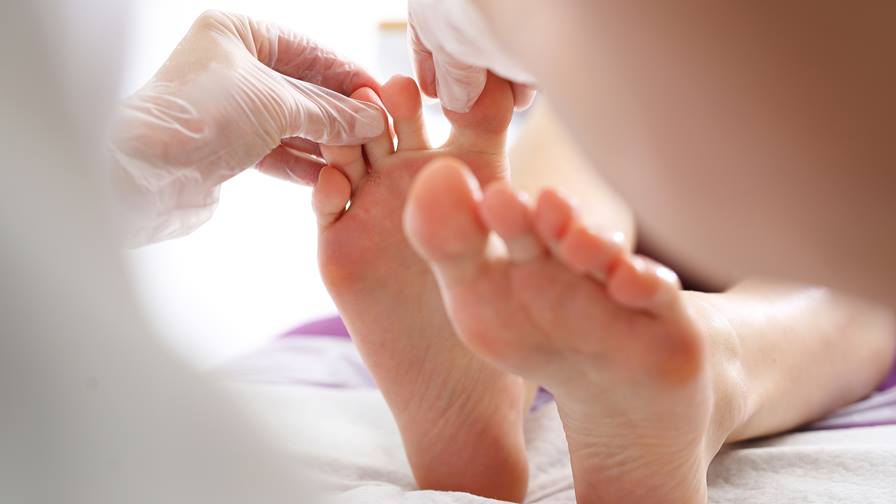Ingrown toenails can be among the most painful and obnoxious things to suffer. If you have this problem too and don’t know how to fix an ingrown toenail, you’ve landed on the right page. Many of us who are plagued with this issue often end up wondering about ingrown toenail removal and whether it’s a painful process. While that is an option for extreme cases, there are certain ways to fix an ingrown toenail without actually having the surgery done. So, if you’ve contemplated getting your ingrown toenail removed, hold that thought for a moment and check out all the ways we’ve listed below that could help you out instead.
Table of Contents
What Is An Ingrown Toenail?
Usually affecting the big toe of your foot, an ingrown toenail is when the nail begins to grow into the soft flesh of your toe. This can be a painful condition and will lead to swelling, redness, and in some cases, an infection. So, how to fix an ingrown toenail? Well, generally this can be treated at right at home but in extreme cases, the intervention of a physician is a must. They can diagnose and help you through the problem without any hassles. So, make sure to get your ingrown toenail checked out if you are unsure whether or not to get it medically treated.
Here are some of the symptoms of an ingrown toenail that will help you identify if you suffer from this problem:
- Swelling of the toe around the nail.
- Redness around the affected toenail.
- Tenderness and pain around both sides of the ingrown toenail.
- The tissue around the toenail gets infected.
What Causes Ingrown Toenails?
Before you learn how to fix an ingrown toenail, let’s take a look at what causes this painful condition. There are many reasons why someone may suffer from ingrown toenails. Some of the most common ones include the following.
- An untoward injury to the toenail.
- Cutting toenails too short or not in an even line.
- Using footwear that crowds your toenail and presses it unnaturally.
- Generally having curved toenails by birth.
The complications an ingrown toenail can lead to include the underlying bone being affected adversely. This could result in serious infection and other complications. The problem could get especially worse if you also suffer from diabetes. The reason is that diabetes will cause poor blood flow to the affected toe and this could damage the nerves in not just the affected area but your entire foot. Gangrene is the most dangerous consequence of this. Also, a minor cut, corn, or even a scrape because of the ingrown toenail will take much longer to heal completely.
How To Fix An Ingrown Toenail Medically
As said earlier, when it comes to ingrown toenail removal, you have to be sure first that you actually need it removed. Visit your doctor and get the correct diagnosis. Let him/her give you the details of your condition and suggest the options. Going by your physician’s advice, pick one medical option that’s best suited for you. Here are the ways in which you can treat ingrown toenails medically:
1. Ingrown toenail removal
Also referred to as complete nail plate avulsion, this is when your doctor decides that it is for the best if your entire toenail removed. Once done, it could take up to 18 months for the entire toenail to grow back. However, the risk with this procedure is that there are high chances that the toenail might be deformed or misshapen when it grows back. What this essentially means is that you face the risk of future ingrown toenails.
2. Surgery on the toe’s tip
This is when your doctor decides to remove and then reshape the incredibly soft tissue located at the tip of your affected toe. Be sure to ask your doctor whether this will reduce the issue of ingrown toenail for you.
3. Wedge resection
This is one of the simplest ways when dealing with how to fix an ingrown toenail. What happens here is the surgeon removes a portion of the ingrown toenail so that it stops growing and digging into the soft flesh of your toe. This procedure is also known as partial nail avulsion.
4. Matrixectomy
This one’s a last resort when it comes to ingrown toenail removal and is used when wedge resection or nail removal surgeries have failed. The procedure involves the ingrown toenail as well as the nail bed removed. Sometimes, the surgeon will cut deep into the nail bed to check if there is any puss and to relieve the swelling of the toenail.
5. Lifting the ingrown toenail
For those wondering how to fix an ingrown toenail that’s not very severe, this is the best option. Also, it’s not really a surgery like the other options mentioned above. Best suited for those suffering from an only slightly ingrown toenail, the procedure involves the doctor lifting the ingrown toenail and inserting dental floss, splint, or cotton under it. What this does is separate the toenail from the nail bed and help the nail to grow straight above the edge of the skin. Back home, you will need to change the material under the toenail everyday and soak the toe.
How long does it take for the toe to recover after an invasive medical procedure?
Regardless of which of the above-ingrown toenail removal and other procedures you need to get done, know that it will take a bit of time for your toenail to grow back fully. Also, there are a few pointers you need to keep in mind when taking care of the toenail that has had surgery done on it. Listed below is the estimated recovery timeline as well as some basic tips to help you take care of your toenail. Do these and you can speed up the process of recovery after you’ve had surgery on your ingrown toenail.
- Ask your doctor to prescribe you an anti-inflammatory drug to help with the pain once the surgery is done.
- Make sure to soak the foot with the ingrown toenail in Epsom salt or warm water everyday.
- The wound needs to be kept bandaged until it heals which could take a couple of weeks.
- Use the ointment or cream prescribed by your doctor on the wound at least twice a day or as often as your doctor asks you to. This is especially a must-do if there happens to be an infection.
- When not soaking your foot in the water, make sure the wound is kept clean and dry as much as possible.
- Choose footwear that’s comfortable and not causing any discomfort or additional pain in the affected area.
- Avoid all kinds of strenuous activity that might put a strain on your toe as this will cause it to become more raw and it will take that much longer to heal.
- NEVER pick at the wound.
The timeline for recovery can differ from one person to the other depending on how serious the surgery is done. For most people though, the toe can heal completely only after several weeks. Needless to say, you will need a lot of patience as this is how to fix an ingrown toenail the right way.
Can There Be Complications Post Surgery?
Well, there may be certain minor complications post-surgery and this is quite common in most people. Serious complications, however, can be a rare case. That being said, if ingrown toenails aren’t treated, that could lead to far more dangerous complications. Listed below are a few things that could happen post-surgery and you need to be prepared for the possibility that they could happen to you.
1. Infection
Surgery anywhere on the body creates an open wound that leaves the rea susceptible to bacterial and other pathogen-related infections. It is of utmost importance to see your doctor immediately in case you feel like you’ve caught an infection.
2. Toenail deformity
This is one of the most common side effects of having surgery to fix an ingrown toenail. Sometimes, the toenails become misshapen or the nail doesn’t grow to its previous length.
3. Complications because of anesthesia
In rare cases, a person may face difficulty waking up from anesthesia. In other cases, the anesthesia may cause the person to have an allergic reaction.
4. Further ingrown toenails
Just because you’ve had surgery to deal with an ingrown toenail doesn’t mean you’ve eliminated the problem. Sometimes, there may be subsequent ingrown toenails and a person may need another – or in some cases multiple – surgeries.
5. Allergic reaction to equipment
When dealing with how to fix an ingrown toenail surgically, few people may have an allergic reaction to the surgical equipment used during the procedure. If you have a latex allergy, you should immediately disclose this vital piece of information to your surgeon.
Home Remedies For How To Fix An Ingrown Toenail
While you now know how to fix an ingrown toenail medically, you should also be aware that it isn’t always a necessity to get the surgery done on it. This is especially true if the problem with your ingrown toenail isn’t that severe. So, instead of opting for an ingrown toenail removal procedure, there are many ways to deal with this issue right at home. Check out some of the best ways to deal with ingrown toenails at home listed below.
- Soak your toe in lukewarm water. This is one of the best ways to calm your inflamed and painful toe. Make sure to do this for at least three to four times a day for a minimum of 15 to 20 minutes. This is because it helps to reduce inflammation and works like a charm to relieve you of the tenderness in the affected area.
- Use an antibiotic cream. An incredible boon when trying to figure out how to fix an ingrown toenail at home, an antibiotic cream will protect your toe from infections. Just make sure to bandage the area after applying the cream as this will keep the ointment locked in place.
- Take painkillers. Just because you don’t need surgery does not mean you should tolerate the pain. Have your doctor prescribe you suitable painkillers which will help you deal with the pain.
- Place dental floss or cotton under the ingrown toenail. Once you’ve soaked your toe for a good 15 minutes, it will make the nail a bit soft. Use this opportunity to place a bit of cotton or some dental floss under the ingrown toenail. What this does is guide the toenail to grow above the edge of the skin.
- Pick the right footwear. This is among the most important things to do when learning how to fix an ingrown toenail at home. You cannot wear shoes that will enclose your affected toenail and make the condition that much worse. Choose footwear that is light and open enough to allow healthy air circulation.
Ingrown Toenailthl Prevention Tips
Knowing how to fix an ingrown toenail is one thing but can this problem be prevented? Well, there are a couple of things you can do to make sure you don’t have to face this painful condition. These are simple lifestyle changes that will help your toenail grow in the right direction. Check them out below.
Make sure the length of your toenail is moderate: Never keep your toenails too long or cut them too short. Both these extremes are risky for your toenail as long ones might break and the short ones will cause extra pressure on your toe. This will make the nail grow into the skin.
Cut toenails straight across: If you have the tendency to develop ingrown toenails, it’s absolutely essential to trim your nails straight across. You must never cut your toenail in a ‘U’ shape to match the shape of your toe. Always cut straight across. If you are unable to do it on your own, visit a podiatrist to get it done the right way.
Keep a check on your feet: This is one of the most important things to do, especially for those who are suffering from diabetes. You must keep a regular check on your feet to make sure you haven’t developed ingrown toenails or any other feet-related problems.
Pick the right footwear: Choosing appropriate footwear is a highly important step when it comes to dealing with both – how to fix an ingrown toenail and/or preventing it. If you wear shoes that suffocate your feet, it will lead to serious complications and not just an ingrown toenail. Pick footwear that’s comfortable and will allow your feet to breathe.
You can also read about how to heal pimple marks or ways to get rid of sunspots from our health archive.





